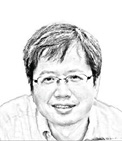FUXING ISLAND To lead cityŌĆÖs riverside transformationYang Jian
FUXING Island, the sole inland island along Shanghai’s Huangpu River, is gaining global attention as a platform for innovation, culture and history.
At the 2025 Yangpu Global Promotion Conference last week, Yangpu District unveiled plans to transform the 1.2ŌĆæsquareŌĆækilometer island, roughly the size of 170 standard football pitches, into a showcase for future urban life.
The island was formed in the 1920s through a major dredging project that cleared silt from the river. Originally called Zhoujiazui Island, it became a key industrial site in the 1930s, home to shipbuilding and a major fish market.
Japanese forces occupied the island in 1937, turning it into a munitions depot. After World War II, it was renamed Fuxing Island, which means “revitalization,” to mark China’s victory.
Today, historical sites such as the White Cottage and Fuxing Island Park preserve its industrial past. Former Kuomintang leader Chiang Kai-shek stayed at the White Cottage in 1949 before retreating to Taiwan.
Since the opening of the Shanghai Quantum City Innovation Base in December 2024, planning on the island has accelerated.
“This island is the core of Yangpu’s innovation zone,” Xue Kan, the district’s Party secretary, told the conference. “It will drive the transformation of more than 8 square kilometers of the surrounding riverside area.”
Yangpu hopes to attract international participation through the Fuxing Island Global Design Competition, which highlights technology, public space, metaverse scenarios and low-altitude economies.
Chen Yixing, a senior manager at Alibaba Cloud, is the lead planner of the design competition. She described the vision as “a sci-fi global landmark for innovation.”
“In terms of strategic value and urban vision, the only place in the world comparable to Fuxing Island is Manhattan in New York,” said Chen.
“It’s rare to find such a site — compact, connected and ready to host a prototype of the future city.”
Yangpu’s wider vision hinges on a framework called “One Island, Two Wings.” To the north and south, the district is developing large tracts of riverside land.
The northern section, adjacent to the island, will become a test bed for future industries and mixed-use urban design.
The southern wing includes the Green Hill, Minghua Sugar Warehouse and Yong’an Pier projects, all renovated from China’s early national industries. These sites blend old industrial buildings with new public and commercial uses.
Yangpu was once one of Shanghai’s industrial engines. In the mid-20th century, it produced a fifth of the city’s total industrial output.
Today, the same share comes from software and information services. In 2024, this sector brought in more than 320 billion yuan (US$45 billion) for the district.
Yangpu is betting on digital economy, smart manufacturing and creative design. It has rolled out more than 20 industry policies to attract talent and support innovation. These include targeted subsidies and funds for demonstration projects.
“We want Yangpu to be a hub where new ideas can land and grow,” said Xu Jianhua, vice director of the district. “Fuxing Island is where that vision becomes reality.”
- About Us
- |
- Terms of Use
- |
-
 RSS
RSS - |
- Privacy Policy
- |
- Contact Us
- |
- Shanghai Call Center: 962288
- |
- Tip-off hotline: 52920043
- µ▓¬ICPĶ»ü’╝ܵ▓¬ICPÕżć05050403ÕÅĘ-1
- |
- õ║ÆĶüöńĮæµ¢░ķŚ╗õ┐Īµü»µ£ŹÕŖĪĶ«ĖÕÅ»Ķ»ü’╝Ü31120180004
- |
- ńĮæń╗£Ķ¦åÕɼĶ«ĖÕÅ»Ķ»ü’╝Ü0909346
- |
- Õ╣┐µÆŁńöĄĶ¦åĶŖéńø«ÕłČõĮ£Ķ«ĖÕÅ»Ķ»ü’╝ܵ▓¬ÕŁŚń¼¼354ÕÅĘ
- |
- Õó×ÕĆ╝ńöĄõ┐ĪõĖÜÕŖĪń╗ÅĶÉźĶ«ĖÕÅ»Ķ»ü’╝ܵ▓¬B2-20120012
Copyright ┬® 1999- Shanghai Daily. All rights reserved.Preferably viewed with Internet Explorer 8 or newer browsers.


